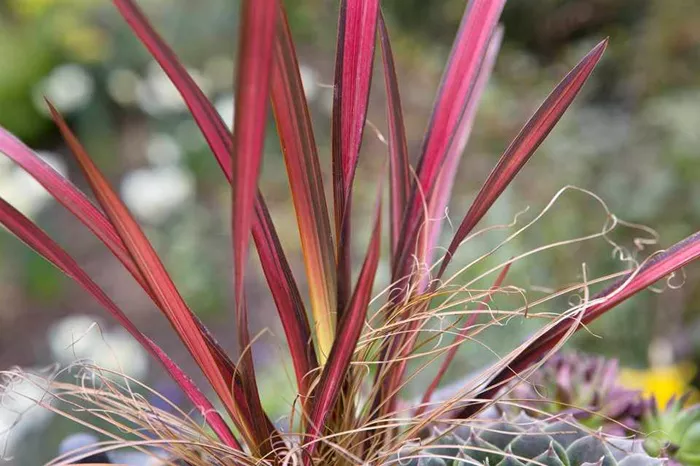Phormium flowers, often referred to as New Zealand flax flowers, are a striking addition to any garden. With their vibrant colors and unique structure, they capture the attention of both gardening enthusiasts and casual observers. These flowers are not only visually appealing but also add a touch of exotic charm to the landscape. In this article, we will explore the appearance of Phormium flowers, their growth habits, and how to incorporate them into your garden.
The Appearance of Phormium Flowers
Phormium flowers are known for their striking and distinctive appearance. They are typically tubular in shape, with each flower resembling a small, elongated trumpet. The petals are usually arranged in a spiral pattern, creating a sense of movement and elegance. The most common colors of Phormium flowers are shades of red, orange, and yellow, although some varieties may also display pink or cream hues. These colors are often vibrant and bold, making the flowers stand out against the green foliage of the plant.
Color Variations and Patterns
The color variations of Phormium flowers are one of their most notable features. The flowers can range from deep red to bright orange and even golden yellow. Some varieties have flowers with a gradient effect, where the petals transition from a darker shade at the base to a lighter shade towards the tips. This gradient adds depth and visual interest to the flowers. Additionally, some Phormium flowers may have stripes or spots, further enhancing their unique appearance. For example, the Phormium ‘Maori Queen’ variety has flowers with red stripes on a yellow background, creating a striking contrast.
Size and Shape
Phormium flowers are relatively small compared to the overall size of the plant. Each flower is usually about 2 to 3 inches in length, with a diameter of around 1 inch. The tubular shape of the flowers makes them ideal for attracting pollinators such as bees and hummingbirds. The flowers grow in clusters on long, slender stalks that rise above the foliage. These stalks can reach heights of up to 6 feet, depending on the variety of Phormium. The clusters of flowers are often densely packed, creating a dramatic display when in bloom.
Growth Habits and Flowering Season
Phormium plants are native to New Zealand, and their growth habits reflect their natural environment. They are evergreen perennials, meaning they retain their foliage throughout the year. The plants have long, sword-like leaves that grow in a fan shape, providing a beautiful backdrop for the flowers. Phormium flowers typically bloom in late spring to early summer, although the exact timing may vary depending on the climate and growing conditions.
Flowering Duration
The flowering season of Phormium plants can last for several weeks. Once the flowers begin to bloom, they gradually open in sequence along the stalk. This staggered blooming pattern ensures that the plant remains visually appealing for an extended period. The flowers themselves have a relatively short lifespan, usually lasting for about a week before they start to fade. However, the continuous blooming of new flowers on the stalk compensates for the short life of individual blooms.
Cultural Significance and Symbolism
Phormium flowers hold cultural significance in New Zealand, where they are often used in traditional Maori art and weaving. The plant’s leaves are harvested to create baskets, mats, and other crafts. In addition to its cultural importance, Phormium is also a popular ornamental plant in gardens around the world. Its unique appearance and hardiness make it a favorite among gardeners who appreciate exotic and visually striking plants.
Incorporating Phormium Flowers into Your Garden
Phormium flowers can add a touch of drama and exotic beauty to any garden. Their vibrant colors and unique shape make them a standout feature. When planning to incorporate Phormium into your garden, consider the following tips:
Choosing the Right Variety
There are several varieties of Phormium available, each with its own unique characteristics. Some varieties have variegated leaves, while others have more vibrant flower colors. For example, the Phormium ‘Jester’ has leaves with yellow and red stripes, adding an extra layer of visual interest. Choose a variety that complements the overall design and color scheme of your garden.
Planting and Care
Phormium plants are relatively low-maintenance, but they do require specific growing conditions to thrive. They prefer well-drained soil and can tolerate a range of soil types, from sandy to clay. Phormium plants also need plenty of sunlight, ideally at least 6 hours of direct sunlight per day. When planting, ensure that the soil is loose and well-aerated to allow for proper root development. Water the plant regularly, especially during the first few months after planting, to help it establish a strong root system.
Companion Planting
Phormium flowers look stunning when paired with other plants that complement their bold colors and unique shape. Consider planting them alongside other perennials with contrasting foliage, such as ferns or hostas. The combination of textures and colors can create a visually dynamic garden bed. Additionally, Phormium plants can serve as a focal point in a garden, drawing the eye and adding structure to the overall design.
Conclusion
Phormium flowers are a captivating and exotic addition to any garden. Their vibrant colors, unique shape, and cultural significance make them a popular choice among gardeners. By understanding their appearance, growth habits, and care requirements, you can successfully incorporate these beautiful flowers into your garden. Whether you choose a variety with bold red flowers or one with variegated leaves, Phormium is sure to add a touch of drama and beauty to your outdoor space.


